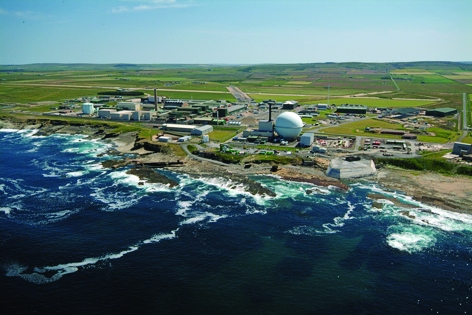Look at a map of Britain’s energy assets and Scotland’s north coast probably wouldn’t feature highly at first glance.
This remote coastline rose to prominence briefly in the middle of the 20th century as the location of Britain’s short-lived experiment with fast breeder nuclear reactors. More than 20 years have passed since Britain abandoned fast reactors and work started to dismantle these relics of the post-war ‘white heat of technology’ era.
The technology that gave rise to the Dounreay site in Caithness is now a £2.6 billion liability on the books of the UK’s Nuclear Decommissioning Authority. But from this expensive legacy a new asset is emerging – and one capable of delivering the next boom in Britain’s energy sector.
The skills base delivering the closure of the site is almost exactly the same as the skills base needed to develop two major industries emerging from the seas around northern Scotland.
Dounreay is on the shoreline of the Pentland Firth, the 20-mile strait where the North Sea meets the Atlantic Ocean. It is a ferocious stretch of water that produces tidal races measured at speeds up to 16 knots.

Studies show the tidal races of the Pentland Firth are capable of producing up to 10GW of renewable energy, or 25 per cent of the total tidal energy capacity of the European Union.
The challenge now is to convert that raw energy to electricity. Crown Estates announced in March the first round of seabed leases. It probably will take a decade and billions of investment to turn the theoretical potential of the Pentland Firth into the world’s biggest underwater power station.
It will need the multi-faceted skills of project management, design engineers, environmental science and others, working in the spotlight of a complex political and regulatory landscape, to bring it to fruition.
So, too, will the offshore oil and gas industry as more of the infrastructure in the North Sea reaches the end of its life.
There are more than 600 installations in the North Sea – 470 of them in the UK sector – and the cost of decommissioning has been estimated at up to £25 billion over the next two decades.
Offshore decommissioning and tidal energy will need the same mix of skills we have here at Dounreay. Over the next decade, many of our skills will become surplus as we get nearer to site closure.
The opportunity for the Nuclear Decommissioning Authority and Dounreay Site Restoration Ltd, as its contractor, is to align the rundown of the workforce at the site with the rise of new industry and facilitate the transfer of these skills.
The workforce here is a major asset for Scotland. DSRL itself, which employs about half the total, has more than 300 staff educated to HND or higher. There are 42 C & I engineers, 14 civil engineers, 10 chemical engineers, 60 electrical engineers and 58 mechanical engineers. I have 54 craftsmen, 37 apprentices, 88 technicians, 15 safety case writers, 74 project managers and 13 professional engineers.
We believe we can finish the job here at Dounreay by 2025, with progressive down-sizing of the workforce between now and then. If we can match the release of staff with the take-up of skills by the offshore sectors, the impact of Dounreay’s closure on the fragile economy of the north Highlands can be positive.
The site currently employs about 2000 people, representing one in every five jobs in this sparsely-populated corner of Europe.
My task is to deliver the shutdown of this site to the NDA. I’m obliged to do that in a way that takes into account the social and economic impact of shutdown. It isn’t just a contractual obligation, however – I firmly believe it’s the right thing to do for a community that has loyally supported a site that’s had more than its share of controversy over the years.
That’s why the NDA has devoted resources to help the community adjust to closure and develop new opportunities for economic development that can sustain the area when Dounreay is gone. We’re supporting a regeneration partnership formed by the leading development agencies and have provided dedicated resources to projects that are preparing the ground for expansion in both offshore decommissioning and tidal energy.
By 2020, I believe this region of the UK can be a world-leader - in successful decommissioning of one of most complex nuclear sites ever built, in tidal energy and offshore decommissioning. The opportunity is ours to grasp.
Simon Middlemas biography
Managing director, Dounreay Site Restoration (DSRL)
Education
Degree in electrical engineering; professional qualifications in marine and nuclear engineering
Career
Many years in the Royal Navy, serving at all major naval bases and aboard the nuclear submarines Renown, Spartan and Sovereign
Three years with Rolls-Royce’s submarines unit in Derby
1999 Naval superintendent at Vulcan Naval Reactor Test Establishment, part of the Dounreay site
2002 Refitting and refuelling nuclear submarines at Plymouth naval base
2004 Joins Dounreay as head of new build projects; subsequently deputy director and acting director
2007 Appointed director of DSRL
Other interests
Vice-president, Royal British Legion
Fund-raiser for RNLI
Member of Scrabster Harbour Board of Management
Model railway enthusiast





Red Bull makes hydrogen fuel cell play with AVL
Formula 1 is an anachronistic anomaly where its only cutting edge is in engine development. The rules prohibit any real innovation and there would be...